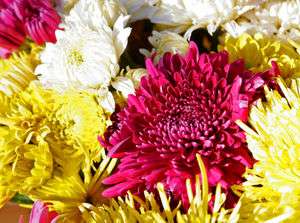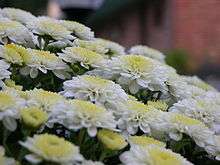Chrysanthemum
< Horticulture| Chrysanthemums | |
|---|---|
 | |
| Genus: | Chrysanthemum |
| Family: | Asteraceae |
| Pollination: | Insects |
Chrysanthemums are a genus (Chrysanthemum) of about 30 species of perennial flowering plants in the family Asteraceae, native to Asia and northeastern Europe. The genus once included many more species, but was split several decades ago into several genera; the naming of the genera has been contentious, but a ruling of the International Code of Botanical Nomenclature in 1999 has resulted in the defining species of the genus being changed to Chrysanthemum indicum, thereby restoring the economically important florist's chrysanthemum to the genus Chrysanthemum. These species were, after the splitting of the genus but before the ICBN ruling, commonly treated under the genus name Dendranthema.
The other species previously treated in the narrow view of the genus Chrysanthemum are now transferred to the genus Glebionis. The other genera split off from Chrysanthemum include Argyranthemum, Leucanthemopsis, Leucanthemum, Rhodanthemum, and Tanacetum. Naming in the horticultural trade is quite inconsistent, with Chrysanthemum and Dendranthema still in common usage.
Description
The species of Chrysanthemum are herbaceous perennial plants growing to 50-150 cm tall, with palmately 3-7 lobed, thick leaves and large flowerheads, white, yellow or pink in the wild species.
Modern chrysanthemums are much more showy than their wild relatives. The flowers occur in various forms, and can be daisy-like, decorative, pompons or buttons. This genus contains many hybrids and thousands of cultivars developed for horticultural purposes. In addition to the traditional yellow, other colours are available, such as white, purple, and red. The most important hybrid is Chrysanthemum × morifolium (syn. C. × grandiflorum), derived primarily from C. indicum but also involving other species.

Chrysanthemum leaves resemble its cousin, the mugwort (Aremisia vulgaris), which is sometimes called wild chrysanthemum.
Growing conditions
Fertile, well-drained, consistently moist soils in full sun to light shade.
Varieties
Several horticultural types are recognized, including:
- Cushions: Plants that grow densely by nature, and need no pinching; Semi-cushions are often advertised as cushions, but may require some pinching;
- Daisies have daisy-like heads
- Doubles have all or mostly ray florets
- Buttons are small doubles
- Pompons are miniature and ball-shaped.
Uses
Chrysanthemums make a welcome addition to the garden, in particular because their late flowering offers advantages when the other garden plants are winding down for winter. Outdoor flowering chrysanthemums will need protection from hard frosts.
Chrysanthemums were cultivated in China as a flowering herb as far back as the 15th century BCE. An ancient Chinese city was named Ju-Xian, meaning "chrysanthemum city". The flower was introduced into Japan probably in the 8th century CE, and the Emperor adopted the flower as his official seal. There is a "Festival of Happiness" in Japan that celebrates the flower.
The flower was brought to Europe in the 17th century. Linnaeus named it from the Greek prefix chrys-, which means golden (the colour of the original flowers), and -anthemon, meaning flower.
Yellow or white chrysanthemum flowers are boiled to make a sweet drink in some parts of Asia. The resulting beverage is known simply as "chrysanthemum tea" (菊花茶, pinyin: jú huā chá, in Chinese).
Chrysanthemum tea has many medicinal uses, including an aid in recovery from influenza. In Korea, a rice wine flavored with chrysanthemum flowers is called gukhwaju (국화주).photo 1photo 2 The leaves of several species such as Chrysanthemum coronarium, the Garland chrysanthemum, which is grown commercially in East Asia as a leaf vegetable, known as tung ho (Template:Zh-cp), shungiku (Template:Lang-ja[シュンギク]) or ssukkat (Template:Lang-ko). In China, the greens are often stir-fried simply with garlic and dried chili peppers. The colour of the cooked greens is dark, their texture dense and mucilaginous, and their flavour fragrant and complex.
Pyrethrum (Chrysanthemum (or Tanacetum) cinerariaefolium) is economically important as a natural source of insecticide. The flowers are pulverized and the active components called pyrethrins, contained in the seed cases, are extracted and sold in the form of an oleoresin. This is applied as a suspension in water or oil, or as a powder. Pyrethrins attack the nervous systems of all insects, and inhibit female mosquitoes from biting. When not present in amounts fatal to insects, they still appear to have an insect repellent effect. They are harmful to fish, but are far less toxic to mammals and birds than many synthetic insecticides and are non-persistent, being biodegradable and also breaking down easily on exposure to light. They are considered to be amongst the safest insecticides for use around food. (Pyrethroids are synthetic insecticides based on natural pyrethrum, e.g., permethrin.)
Maintenance
Fall-blooming species benefit from being cut back about 1/2 way down in midsummer in order to encourage a bushy habit.
Propagation
Division or cuttings.
Pests and diseases
- Erwinia chrysanthemi
Fasciation
- Corynebacterium fascians
Crown Gall
- Agrobacterium tumeifasciens
Bacterial Leaf Spots
- Pseudomonas cichorii
- Erysiphe cichoracearum
- Alternaria chrysantemi
- Cercospora chrysanthemi
- Cylindrosporium chrysanthemi
- Phyllosticta chrysanthemi
- Septoria chrysanthemella
- Septoria chrysanthemi
Gray Molds
- Botrytis cinerea
Ray Blight
- Mycosphaerella ligulicola (synonym: Ascochyta chrysanthemi)
Ray Speck
- Alternaria
- Stemphylium
Stem Rots
- Fusarium
- Pellicularia filamentosa
- Fusarium oxysporum var. tracheiphilum
- Pythium aphanidermatum
- Verticillium albo-atrum
- Puccinia chrysanthemi
Viruses
- Flower Distortion: Chrysanthemum Flower Distortion Virus
- Wilt: Tomato Spotted Wilt Virus
- Aspermy: Tomato Aspermy Virus
- Mosaic
- Rosette
Viroids
- Stunt
- Chlorotic Mottle
Phytoplasma
- Aster Yellows
- Foliar Nematode: Aphelenchoides ritzemabosi
- Root Knot: Meliodgyne hapla
- Root Knot: Meliodgyne incognita
- Chrysanthemum Aphid: Macrosiphoniella sanborni
- Foxglove Aphid: Acyrthosiphon solani
- Green Peach Aphid: Myzus persicae
- Leaf Curl Plum Aphid: Brachycaudus helichrysi
- Melon Aphid: Aphis gossypii
- Thistle Aphid: Anuraphis cardui
Scales
- Hemispherical Scale: Saissetia coffae
- Four-Lined Plant Bug: Poecilocapsus lineatus
- Harlequin Bug: Murgantia histrionica Southern US
- Tarnished Plant Bug: Lygus lineolaris
- Chrysanthemum Lace Bug: Corythucha marmorata
- Mexican Mealybug: Phenacoccus gossypii
- Citrus Mealybug: Planococcus citri
- Ground Mealybug: Rhizocecus falcifer
- Greenhouse Whitefly: Trialeurodes vaporariorum
- Silverleaf Whitefly: Bemisia argentifolii
- Western Flower Thrips: Frankliniella occidantalis
- Banded Greenhouse Thrips: Hercinothrips femoralis
- Greenhouse Thrips: Heliothrips haemorrhoidalis
Flies
- Chrysanthemum Gall Midge: Diarthronomyia chrysanthemi
- Chrysanthemum Leaf Miner: Phytomyza syngenesiae (synonym: Chromatomyia syngenesiae):
- Serpentine Leaf Miner: Liriomyza brassicae (Amauromyza maculosa):
Beetes
- Asiatic Garden Beetle: Maladerma castanea
- Blister Beetle: Epicauta spp.:
- Japanese Beetle: Popillia japonica
- Fuller Rose Beetle: Pantomorus cervinus
- Rose Chafer Beetle: Macrodactylus subspinosus
- Spotted Cucumber Beetle: Diabrotica undecimipunctata
- Japanese Weevil: Callirhopalus bifasciatus (Pseudoneorhinus bifasciatus)
- Yellow Woolybear Caterpillar: Diacrisia virginica
- European Corn Borer: Ostrinia nubilalis
- Stalk Borer: Papaipema nebris
- Variegated Cutworm: Peridroma saucia
- Greenhouse Leaf Tier: Udea rubigalis
- Cabbage Looper: Trichoplusia ni
- Corn Earworm: Helicoverpa zea
- Beet Armyworm: Spodoptera exigua
- Checkerspot Butterfly Caterpillar: Euphydryas chalcedona
- Omnivorous Leafroller: Platymota stultana
- Plantain Looper: Autographa precationis
- Soybean Looper: Pseudoplusia includens
- Tobacco Budworm: Heliothis virescens
- Zebra Caterpillar: Ceramica picta
- w:list of Lepidoptera which feed on Chrysanthemum
Termites
- Eastern Subterranean Termite: Reticulitermes flavipes
- Broad Mite: Polyphagotarsonemus latus
- Cyclamen Mite: Steneotarsonemus pallidus
- Two-spotted Spider Mite: Tetranychus urticae
References
- Christopher Brickell and Judith D. Zuk (1997). The American Horticultural Society A-Z Encyclopedia of Garden Plants. DK Publishing. pp. 353.
- Pirone, Pascal P. (1978). Diseases & Pests of Ornamental Plants (Fifth Edition ed.). John Wiley & Sons, New York. pp. 194-201.
- Cranshaw, Whitney (2004). Garden Insects of North America: The Ultimate Guide to Backyard Bugs. Princeton University Press. pp. 588.
- Pippa Greenwood, Andrew Halstead, A.R. Chase, Daniel Gilrein (2000). American Horticultural Society Pests & Diseases: The Complete Guide to Preventing, Identifying, and Treating Plant Problems (First Edition ed.). Dorling Kindersley (DK) Publishing, inc.. pp. 198.